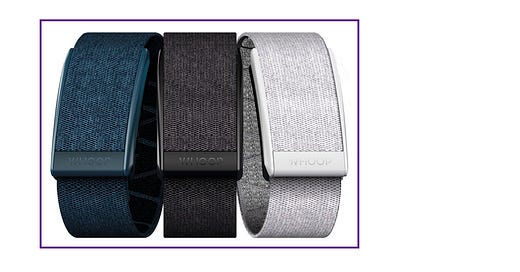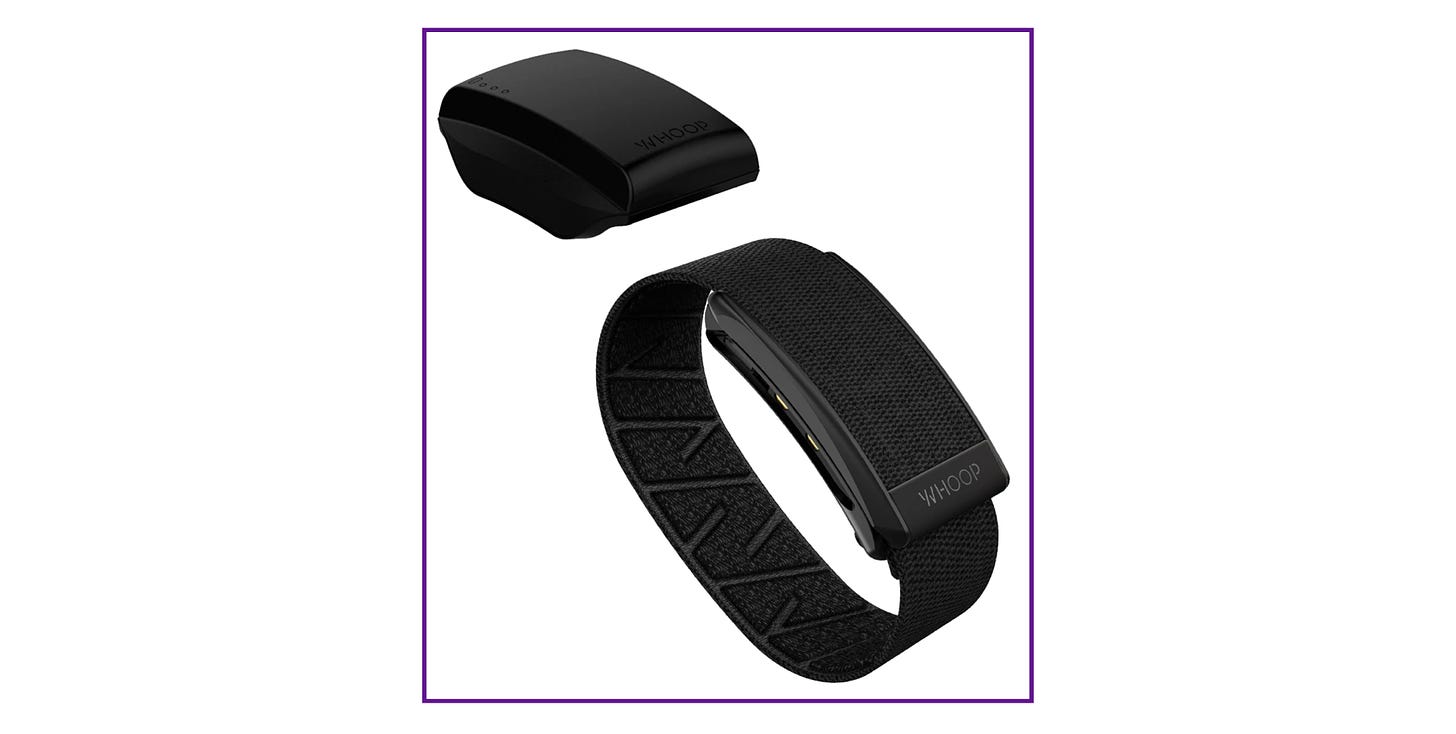Why WHOOP is the Biggest Threat to Apple Watch
The general public is more ready than ever for performance optimization as a service.
SaaS Pricing is hard. PricingSaaS is your cheat code.
Monitor competitors, track real-time benchmarks, discover new strategies, and more.
There’s only so much room on our wrists.
While Fitbit, Garmin, and other brands have captured some market-share, Apple has had a lock on the aspirational healthy and wealthy ever since launching the Apple Watch in 2015.
To be clear, I do not believe the Apple Watch is in trouble. The Apple ecosystem is formidable, and the watch is an incredible product that keeps getting better.
That said, the Apple Watch is a bundle, and the nature of bundles is that they serve breadth over depth, revealing areas of opportunity for highly-focused companies to serve a specific niche.
There is one company that fits this description that I believe will take up more real estate on Apple’s corner in the coming years. That company is WHOOP.
For the unfamiliar, WHOOP is a fitness tracker and membership that sounds too good to be true. After as little as four months, members report:
better sleep
fewer injuries
less alcohol consumption
improved Heart Rate Variability and Resting Heart Rate
While other wearables optimize for surface-level data across activity, heart rate, and sleep, WHOOP optimizes for depth. This allows them to provide not only data but insights.
To surface these insights, WHOOP goes deeper than other fitness trackers, measuring Heart Rate Variability rather than Heart Rate alone. Between the beats, their homepage reads, lie the secrets your body is trying to tell you.
To reach this level of granularity, WHOOP has to collect more data than other fitness trackers - a LOT more. As the key differentiator underpinning their entire value proposition, they prioritize data collection at all costs, and it informs everything they do, from product design to packaging to positioning.
This focus has helped WHOOP build resilience in one of the most competitive markets in consumer products and is about to take them from a niche player to widespread adoption.
So, what makes WHOOP so different?
Built with Purpose
In order for WHOOP to make actionable recommendations, the band needs to collect tons of data. Two factors power this data collection, and both tie directly back to their product design.
First, the sensors in their band take more measurements than other wearables. Second, members can wear the band 24/7. Let’s start with the sensors.
While Apple Watch typically collects heart rate data once every minute or so, WHOOP collects 100 measurements per second. This stark difference means WHOOP makes some big tradeoffs. While Apple Watch has a beautiful visual display that you just want to play with, WHOOP employs a minimalist design made up of a strap and a sensor.
The WHOOP band, though aesthetically pleasing in its own way, is completely utilitarian, making the mobile application the primary place for interaction. In fact, the only way to interact with the strap is to double-tap it, which will tell you if the battery is at full charge, medium charge, or running low.
Battery life is another key difference between WHOOP and Apple Watch, and further illustrates how far they’ve gone to maximize data collection. Despite taking way more measurements, WHOOP can hold a charge for 5 days, dwarfing the 18-hour battery life of an Apple Watch.
The battery life alone is impressive, but WHOOP doesn't stop there. Instead of following the conventional route and forcing members to take off their band to charge, WHOOP designed a charger that slips over the band and delivers a full charge in 60 minutes.
This combination of advanced sensors and 24/7 tracking is WHOOP’s special sauce. It allows the band to detect micro-changes in how your body responds to activity, rest and everything in between. This powers their biggest differentiator. While most fitness trackers stop at data collection, WHOOP tells you what the data actually means.
This difference is critical to their packaging strategy, which serves as another key departure from the rest of the market.
Performance Optimization as a Service
Most wearables are sold as a piece of hardware for a one-time cost. Apple Watch, Fitbit, and Oura ring all follow this model.
While Fitbit offers a premium subscription at $10/month, it's optional. You can also pay for an Apple Watch in monthly installments, but that’s just a difference in payment terms rather than business model.
WHOOP doesn’t give you a choice, the membership subscription is mandatory. Even if you wanted to, you couldn’t purchase the band outright. The WHOOP strap is really just a trojan horse for their services offering.
Rather than packaging themselves as just another wearable device, the membership model positions WHOOP as what they really are: performance optimization as a service. From the granular data the band collects, they deliver a range of insights and services. Let’s highlight how they compare with Apple Watch.
Apple Watch and WHOOP both center their reporting around 3 key measurements. Apple Watch tracks the 3 Rings, which include calories burned, time spent in demanding exercise, and how much time spent moving or standing:
This data is helpful to ensure you’re meeting benchmarks for a generally healthy day, but it doesn’t tell you anything about your physiological state. WHOOP’s granularity allows for deeper data and recommendations based on that data.
Again, their 3 primary metrics measure sleep, recovery and strain. Let’s unpack each.
Every morning, members get a report on how they slept, including sleep quality, latency and efficiency.
In addition to the report, members can use WHOOP Journal to track the impact of lifestyle factors on sleep quality, including alcohol consumption, intermittent fasting, and CBD usage. Members attest to the power of the results, citing the journal as a major reason for cutting back on alcohol.
But it’s not just data. WHOOP’s Sleep Coach feature gives personalized recommendations, including optimal bedtime and wake-up times given your current physiological state.
While the merits of wearables for sleep measurement have been highly contested, a recent study from the University of Arizona validated WHOOP as the most accurate, non-invasive sleep monitor.
Next is recovery.
In his autobiography, The Mamba Mentality: How I Play, Kobe Bryant states that listening to his body was critical to elite performance. His native sense of how he felt dictated his training, preparation, and pre-game warm-ups. WHOOP productizes this notion with its recovery score.
Pulling data from the heart, nervous system and sleep performance, the score is expressed as a percentage out of 100 (e.g., 70% recovered), and signifies your readiness to take on strain. In reviews, members praise the accuracy of recovery score, even saying it can alert you to being sick before symptoms appear.
Lastly, there’s strain, which is a personalized, numerical measurement based on average heart-rate during workouts.
Along with a live strain score, WHOOP offers Strain Coach, which gives live feedback during workouts to help members avoid injury.
These metrics don’t exist in silos. The beauty lies in their interconnectedness. WHOOP CEO, Will Ahmed puts it eloquently:
It’s a cycle,” he says, “How much you’ve recovered dictates how much you can strain, which dictates how much more recovery you need.
The daily reports and measurements also tie into the WHOOP member community, allowing you to compare your performance to benchmarks across members in similar age brackets. Members can even engage in friendly competition by creating or joining WHOOP teams.
It’s easy to see WHOOP teams evolving into local meetups and hang-outs, allowing amateur athletes to feel like part of an elite fitness club. This aligns perfectly with the aspirational positioning WHOOP has embraced from the get-go.
Athletes Only
While Apple Watch has always been positioned for the broader market, WHOOP started off with a very specific buyer persona. In the early years, WHOOP aggressively targeted elite athletes, staging a direct assault on other fitness trackers in the process.
What I love about this is that it shows from day one, WHOOP knew their ideal customer. They weren’t looking for widespread adoption, but athletes that laugh at the idea of counting steps.
While subsequent copy softened, their early aggression was critical to building advocacy among the most serious fitness cohort. While the general public may not have been thinking about the impact of tracking sleep, strain and recovery back in 2015, you can bet professional athletes and Crossfit devotees were looking for an edge.
Targeting elite athletes allowed WHOOP to tailor their product to the group that would care most about this data, and perfect a product that would satisfy their needs. By starting with the most hardcore users, WHOOP ensured the product would deliver above and beyond expectations for the general public if and when they developed an appetite for this level of depth.
Had they gone for a wider audience originally, there would likely be more mixed feedback and negative reviews from users that just weren’t as serious about their performance.
Instead, they’ve cultivated a devoted member-base of data addicts. Case in point, DeAndre Jordan wears his WHOOP strap under his sweatband during games even though the band is still considered illegal in the NBA. He’s literally violating rules for this data.
Lastly, targeting elite athletes has an aspirational trickle-down effect. People want to identify themselves with elite performers. This mentality has powered sneaker sales for years, with young basketball players buying their favorite players' sneakers. I still remember feeling like a badass when I got my first pair of Jordans in middle school.
While exclusively targeting elite athletes made sense in the beginning, the evolution of the fitness and wellness landscape over the last five years has shifted dramatically, positioning WHOOP for a much wider breakout.
The New Normal
In 2016, Arianna Huffington published The Sleep Revolution and in 2017, Matt Walker published Why We Sleep. Both books were New York Times best-sellers and captured a new focus on sleep and recovery in the general psyche.
Alongside this rise in public consciousness came the boutique fitness boom, with an explosion of small studios offering expensive classes proving that people are willing to pay for a sense of community.
At the same time, the proliferation of apps across fitness, wellness, and nutrition has given health-conscious consumers more nuanced tracking options than ever, leading to a much more data-driven populace than five years ago.
It’s in this new context that I recently heard Bill Simmons sing his praises for WHOOP in an ad read for his flagship podcast. Simmons is pretty much as close as to the monoculture as you can get these days, with over 100 million monthly downloads of his show. Granted his focus is sports, and his audience likely has a decent amount of athletes, his most common advertisers, brands like ZipRecruiter, Stamps.com, and SeatGeek don’t exactly scream niche.
While I would have been surprised to hear Simmons read a placement for WHOOP a few years ago, widespread promotion seems fitting today. Personalized data and community are two of the most important trends in health and fitness right now, and WHOOP sits at the intersection of both.
Their relentless focus has put them head and shoulders above other wearables in terms of data granularity, and their membership model has set the groundwork for a tiered packaging structure with premier services for consumers that want even more out of their WHOOP membership.
As the general public marches further along the path of relentless self-improvement, I expect to see a lot more WHOOP straps out in the wild.
Enjoying Good Better Best?
If you enjoyed this post, I’d love it if you hit the “like” button, that way I’ll know which posts are resonating the most!
If you have thoughts or feedback, I’d love to hear from you! You can find me on Twitter here.









+100, great article. I've been a longtime Whoop user and I'm just starting to notice more of them out in the wild this year